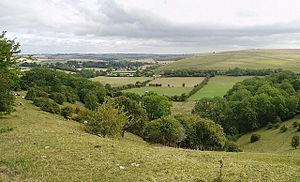Bowerchalke Downs facts for kids
Bowerchalke Downs is a beautiful area of hills in Wiltshire, England. It's also known by other names like Woodminton and Marleycombe Down. This special place covers about 128.6 hectares, which is like 300 football fields! It was officially recognized as a Site of Special Scientific Interest (SSSI) in 1971. The downs are located right next to the village of Bowerchalke. They are also close to the borders of Hampshire and Dorset counties. Bowerchalke Downs is part of the Cranborne Chase and West Wiltshire Downs Area of Outstanding Natural Beauty. It is also a key part of the chalky hills found across Southern England.
Contents
What is a Site of Special Scientific Interest?
A Site of Special Scientific Interest (SSSI) is a protected area in the UK. These places are chosen because they have very important plants, animals, or geological features. The Bowerchalke Downs SSSI was set up to protect its unique chalk grassland.
Why Bowerchalke Downs is Special
In 1971, English Nature described Bowerchalke Downs as a place with many different kinds of flowers. This type of chalk grassland is becoming very rare. This is because farming methods have changed over time. The downs are on a chalky hillside that looks over the Ebble Valley in South Wiltshire. The slopes face different directions, which helps many types of plants and animals to grow here. Some of these species are rare in the UK.
Amazing Plants of the Downs
Most of the area has rich grassland. You can find grasses like sheep's-fescue and meadow oat-grass. Other common plants include quaking-grass, salad burnet, small scabious, and cowslip.
Many special plants grow here because the land is cared for naturally. This means no chemical fertilisers, weed killers, or ploughing are used. These plants include clustered bellflower, frog orchid, chalk milkwort, and betony.
You'll also see other plants scattered around. These include glaucous sedge, spring-sedge, wild carrot, and kidney vetch. Sometimes, these plants grow in large groups.
A special type of grass called dwarf sedge is very common here. This grass is mostly found in the downs of south west Wiltshire and Dorset. Two other rare plants are early gentian and musk orchid. The musk orchid grows in an area that has many different orchids. These include pyramidal, bee, common spotted, fragrant, and twayblade orchids.
In areas where sheep graze less, taller grasses grow. These include upright brome, hairy oat-grass, cock's-foot, and false oat-grass. You'll also find herbs like yellow rattle, greater knapweed, and common knapweed. Salad burnet and cowslip are also common here. In these spots, you might see meadow saxifrage. There are also small groups of greater butterfly orchid and adder's-tongue.
Trees and Bushes
You can find scattered bushes and trees on some of the slopes. In a few places, they grow very thick. There are many different kinds of shrubs and trees. These include hawthorn, blackthorn, wayfaring tree, gorse, whitebeam, hazel, and ash.
Wonderful Wildlife
The Anthills made by yellow meadow ants are a common sight on many slopes. The grassland is home to many kinds of butterflies. These include the dingy skipper, dark green fritillary, and common blue.
The adonis blue butterfly also lives here. It needs a plant called horseshoe vetch to grow. This butterfly is only found in a few chalk and limestone grassland areas in the south of Britain.
Many birds also live or visit Bowerchalke Downs. You might see skylarks, corn buntings, yellowhammers, and grey partridges. Both green and great spotted woodpeckers come to feed. Buzzards and kestrels hunt for food in the area too.


